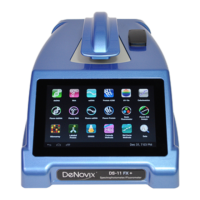
Do you have a question about the DeNovix DS-11 Series and is the answer not in the manual?
| Wavelength Range | 190 - 840 nm |
|---|---|
| Minimum Sample Size | 0.5 µL |
| Sample Volume | 0.5 - 2 µL |
| Absorbance Precision | 0.002 AU (1 cm equivalent) |
| Operating System | Android |
| Display | 7-inch touchscreen |
| Power Requirements | 100 - 240 V, 50/60 Hz |
| Pathlength | 0.5 mm (auto-ranging) |
Describes the compact DeNovix Spectrophotometers/Fluorometers and their integrated processor and touchscreen.
Lists key features including integrated processor, touchscreen, Android interface, EasyApps, 1 µL/Cuvette analysis, and 4-channel fluorescence.
Instructions for unpacking, connecting power, and powering on the instrument.
Important warnings regarding cover removal, operating conditions, and power supply usage.
Visual representations of common functions and actions within the software interface.
Explanation of various buttons used in the software for Absorbance and Fluorescence apps.
How to navigate through the instrument's software interface using tabs and buttons.
Information displayed in the bottom action bar regarding updates, backups, and connectivity.
Displays measurement results including application-specific data fields for each sample.
Visualizes spectral data or concentration results, allowing overlay and selection.
Procedure for performing measurements using 1 µL of sample on the instrument.
Procedure for performing measurements using cuvettes, detailing specifications and insertion.
Details of the interface elements on the Run screen for absorbance measurements.
Guidelines for obtaining accurate absorbance measurements, focusing on cleaning and sample handling.
Step-by-step guide to quantify nucleic acid samples using absorbance values.
Details on apps for dsDNA, RNA, and ssDNA, including sample type and factor inputs.
Procedure for quantifying nucleic acid samples using absorbance and dye-specific wavelengths.
List of 11 preconfigured dye types for Microarray and Labeled Proteins applications.
Step-by-step guide to quantify purified protein and peptide samples using absorbance.
Quantifying samples based on absorbance values at 280 nm, including sample type and concentration results.
Quantifying protein samples based on absorbance and dyes/fluorophores.
Quantifying low concentration peptide samples, noting aromatic residue absence.
Step-by-step guide for performing colorimetric assays and generating standard curves.
Detailed steps for creating a new standard curve or importing a saved one.
Determining a best-fit trend line using replicate averages for concentration calculation.
How to save and reuse standard curves or concentration lists for later use.
Step-by-step guide to monitor up to 6 specific analysis wavelengths.
Options for selecting wavelength ranges (220-750 nm or 190-840 nm) for UV-Vis analysis.
Using a movable cursor on the graph to find absorbance values at specific wavelengths.
Applying baseline correction using a specified wavelength for UV-Vis measurements.
Procedure to determine optical density of microbial cell cultures at 600 nm.
Details on A600 measurement and cell number conversion factor for OD 600 app.
Baseline correction for OD 600 measurements, typically not bichromatic normalization.
Step-by-step guide for performing cuvette-based kinetic measurements.
Parameters for defining a kinetic method: name, wavelengths, ranges, and heater set point.
Defining timed intervals for kinetic measurements: delay, interval, and duration.
Features on the Run screen for Kinetics: method selection, graph types, heater control, timer, and stop button.
Steps to create, save, and access user-defined absorbance methods.
Essential parameters for defining a new method: name, analysis wavelength, and baseline correction.
Creating standard curves using custom methods and their similarity to preconfigured Colorimetrics apps.
Using formula methods to monitor additional results or perform routine calculations.
Procedure for performing fluorescence measurements using the FX module and micro tubes.
Guidelines for accurate fluorescence measurements, covering sample concentration, volume, and handling.
Steps to launch, select assay type, and generate a new curve for fluorescence.
Interface for selecting assays and generating/using standard curves.
How to select an assay from the drop-down menu and the role of preconfigured entries.
Options for generating new curves, using previous ones, and setting blank/trend line parameters.
Procedure for using the instrument as a versatile fluorometer for QC and assay development.
Selecting fluorophore/LED and viewing RFU results across multiple emission channels.
Exporting data via email, network folder, or USB flash drive as .csv files.
Standard and custom formats for exporting data, including defining new formats.
Sending screen captures and .csv files via email, with Address Book feature.
Sending data, captures, and backups to network folders using SMB or FTP.
Manages settings, saved data, and user methods, used for data segregation.
Details on preconfigured Primary Administrator and General accounts.
Creating and managing administrator and standard user accounts, including password protection.
Defining application-specific default settings on a per account basis.
Provides three calculators: Oligo, Scientific, and Dilution calculators.
Analyzes DNA/RNA sequences for length, molecular weight, GC content, and melting temp.
Standard calculator for mathematical and scientific functions.
Calculates stock solution amounts needed for a specified final concentration.
Procedures for routine and additional cleaning of sample surfaces.
Recommendations for cleaning the screen and avoiding specific cleaning agents.
Performing self-tests for microvolume and cuvette modes to check instrument performance.
Resets the lamp optimization, used when method optimization is suspect.
Verifying microvolume pathlengths using LC-NA verification fluid.
Troubleshooting low/high absorbance values and high standard deviations in verification checks.
General advice for issues related to accuracy, reproducibility, and purity ratios.
Troubleshooting steps for microvolume measurements: cleaning, pipetting, and sample handling.
Troubleshooting tips for cuvette measurements: Z heights, UV transparency, and pathlength selection.
Troubleshooting fluorescence measurements: sample volume, bubbles, and assay parameters.
Information regarding warranty coverage for products and accessories.
Statement on document completeness and liability for errors or omissions.